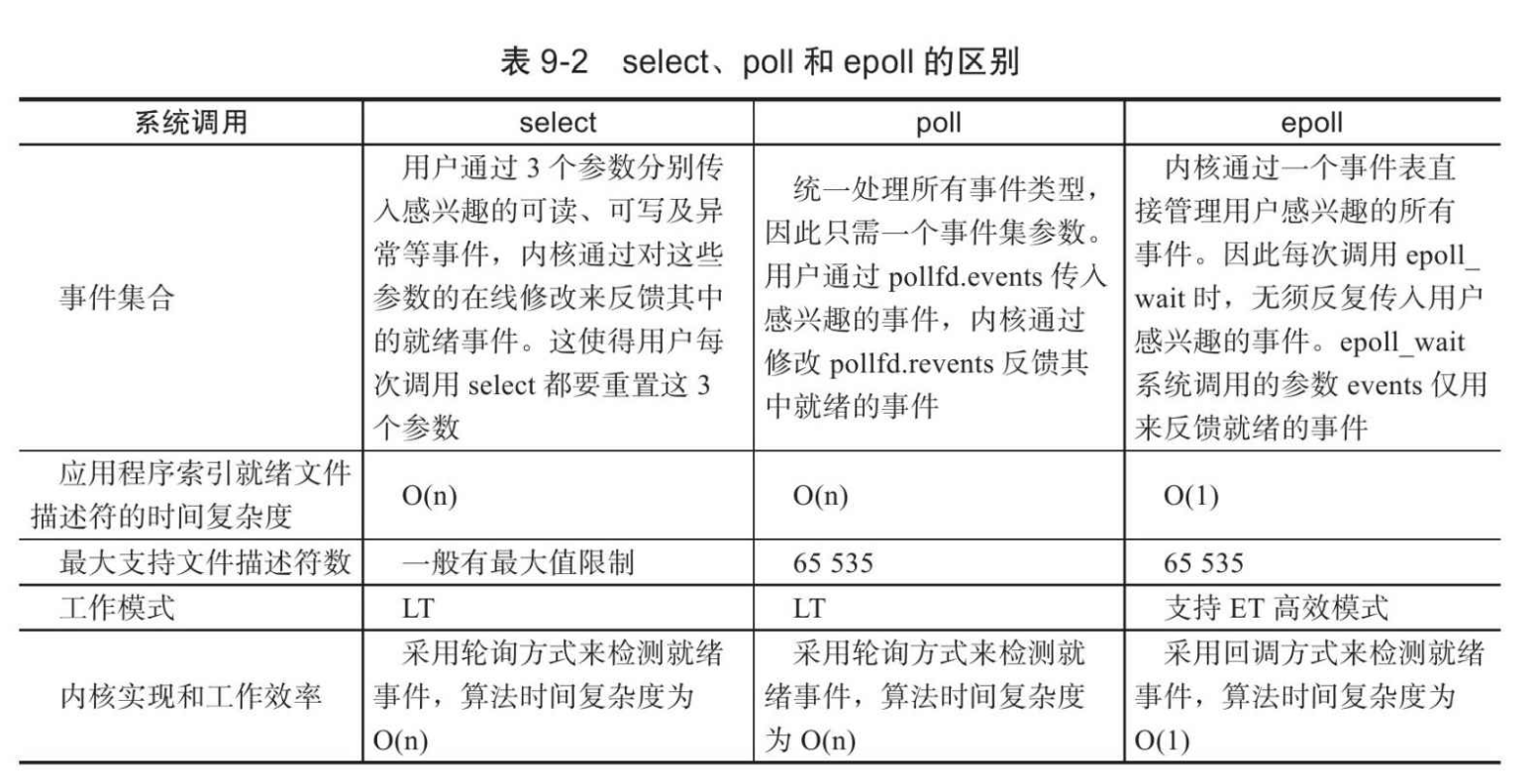I/O 复用
本文是《Linux 高性能服务器编程》阅读记录,供以后查阅参考。推荐阅读原书。
所有函数未标明需要包含什么头文件,可使用
man命令自行查询。
1. select
select
系统调用用于:在一段指定的时间内,监听用户感兴趣的文件描述符上的可读、可写和异常等事件。
1.1 select API
select 函数原型:
1 | |
nfds:指定被监听的文件描述符的总数。通常设置为select监听的所有文件描述符中的最大值 + 1,因为文件描述符从 0 开始计数。readfs:指向可读事件对应的文件描述符集合;writefs:可写;exceptfs:异常;select调用返回时,系统将修改这些文件描述符来通知应用程序哪些文件描述符已就绪。fd_set结构体类型定义如下:1
2
3
4
5
6
7
8
9
10
11
12
13
14
15
16
17
18
19
20
21
22
23/* The fd_set member is required to be an array of longs. */
typedef long int __fd_mask;
/* Some versions of <linux/posix_types.h> define this macros. */
#undef __NFDBITS
/* It's easier to assume 8-bit bytes than to get CHAR_BIT. */
#define __NFDBITS (8 * (int) sizeof (__fd_mask))
#define __FD_ELT(d) ((d) / __NFDBITS)
#define __FD_MASK(d) ((__fd_mask) (1UL << ((d) % __NFDBITS)))
/* fd_set for select and pselect. */
typedef struct
{
/* XPG4.2 requires this member name. Otherwise avoid the name
from the global namespace. */
#ifdef __USE_XOPEN
__fd_mask fds_bits[__FD_SETSIZE / __NFDBITS];
# define __FDS_BITS(set) ((set)->fds_bits)
#else
__fd_mask __fds_bits[__FD_SETSIZE / __NFDBITS];
# define __FDS_BITS(set) ((set)->__fds_bits)
#endif
} fd_set;即:
fd_set结构体成员仅包含一个整型数组,数组每个元素的每一位(bit)标记一个文件描述符。fd_set能容纳的文件描述符数量由FD_SETSIZE指定,这限制了select能同时处理的文件描述符总量。系统提供了以下宏,以便于用户读写
fd_set中的 bit:1
2
3
4
5
6#include <sys/select.h>
FD_ZERO(fd_set *fdset); // 清除 fd_set 所有位
FD_SET(int fd, fd_set *fdset); // 设置 fd_set 位 fd
FD_CLR(int fd, fd_set *fdset); // 清除 fd_set 位 fd
int FD_ISSET(int fd, fd_set *fdset); // 测试 fd_set 的位 fd 是否被设置timeout:设置select函数的超时时间,类型是tomeval结构体:1
2
3
4
5
6
7/* A time value that is accurate to the nearest
microsecond but also has a range of years. */
struct timeval
{
long tv_sec; /* Seconds. */
long tv_usec; /* Microseconds. */
};如果传递给
timeoutNULL指针,则select将阻塞,直到某个文件描述符就绪。返回值:成功时返回就绪(可读、可写和异常)文件描述符的总数。如果超时后没有任何文件描述符就绪,返回 0。失败时返回 -1 并设置
errno。如果在select等待期间,程序收到信号,则select立即返回 -1,并设置errno为EINTR。
1.2 文件描述符就绪条件
socket可读情况:socket内核接收缓冲区中的字节数大于或等于其低水位标记SO_RCVLOWAT。此时我们可以无阻塞的读该socket且返回的字节数大于 0。socket通信的对方关闭连接。此时读取socket返回 0。监听
socket上有新的连接请求。socket上有未处理的错误。此时我们可以使用getsocketopt来读取和清楚该错误。
socket可写情况:socket内核发送缓冲区中的字节数大于或等于其低水位标记SO_SNDLOWAT。此时我们可以无阻塞的写该socket且返回的字节数大于 0。socket的写操作被关闭。对写操作被关闭的socket执行写操作将触发一个SIGPIPE信号。socket使用非阻塞connect连接成功或者失败(超时)之后。socket上有未处理的错误。此时我们可以使用getsocketopt来读取和清楚该错误。
socket异常情况:select能处理的异常情况只有一种:socket接收到带外数据。
2. poll
poll 函数原型如下:
1 | |
fds:一个pollfd结构体类型数组,结构体定义如下:1
2
3
4
5
6
7/* Data structure describing a polling request. */
struct pollfd
{
int fd; /* File descriptor to poll. */
short int events; /* Types of events poller cares about. */
short int revents; /* Types of events that actually occurred. */
};其中,
fd成员指定文件描述符;events成员告诉系统监听fd上的哪些事件,是一系列事件的按位或;revents成员由内核修改,通知应用程序fd实际上发生了哪些事件。poll支持的事件类型如下:1
2
3
4
5
6
7
8
9
10
11
12
13
14
15
16
17
18
19
20
21
22
23
24
25
26
27
28/* Event types that can be polled for. These bits may be set in `events'
to indicate the interesting event types; they will appear in `revents'
to indicate the status of the file descriptor. */
#define POLLIN 0x001 /* There is data to read. */
#define POLLPRI 0x002 /* There is urgent data to read. */
#define POLLOUT 0x004 /* Writing now will not block. */
#if defined __USE_XOPEN || defined __USE_XOPEN2K8
/* These values are defined in XPG4.2. */
# define POLLRDNORM 0x040 /* Normal data may be read. */
# define POLLRDBAND 0x080 /* Priority data may be read. */
# define POLLWRNORM 0x100 /* Writing now will not block. */
# define POLLWRBAND 0x200 /* Priority data may be written. */
#endif
#ifdef __USE_GNU
/* These are extensions for Linux. */
# define POLLMSG 0x400
# define POLLREMOVE 0x1000
# define POLLRDHUP 0x2000
#endif
/* Event types always implicitly polled for. These bits need not be set in
`events', but they will appear in `revents' to indicate the status of
the file descriptor. */
#define POLLERR 0x008 /* Error condition. */
#define POLLHUP 0x010 /* Hung up. */
#define POLLNVAL 0x020 /* Invalid polling request. */nfds:指定被监听事件集合fds的大小,其类型定义如下:1
2/* Type used for the number of file descriptors. */
typedef unsigned long int nfds_t;timeout:指定超时值,int类型,单位毫秒。-1 表示poll调用将阻塞直到某个事件发生;0 调用立即返回。返回值:含义与
select相同。
3. epoll
3.1 内核事件表
epoll 是 Linux 特有的 I/O 复用函数。它在实现和使用上与
select、poll
有很大差异。首先,epoll
使用一组函数来完成任务,而不是单个函数。其次,epoll
把用户关心的文件描述符上的事件放在内核里的一个事件表中,从而无须像
select 和 poll
那样每次调用都要重复传入文件描述符集或事件集。但 epoll
需要使用一个额外的文件描述符,来唯一标识内核中的这个事件表。这个文件描述符使用
epoll_create 函数创建:
1 | |
函数返回的文件描述符将用于后续 epoll
相关函数的第一个参数,以指定要访问的内核事件表。
操作 epoll 内核事件表的函数 epoll_ctl:
1 | |
op:指定操作类型,有以下三种:1
2
3
4/* Valid opcodes ( "op" parameter ) to issue to epoll_ctl(). */
#define EPOLL_CTL_ADD 1 /* Add a file descriptor to the interface. */
#define EPOLL_CTL_DEL 2 /* Remove a file descriptor from the interface. */
#define EPOLL_CTL_MOD 3 /* Change file descriptor epoll_event structure. */分别表示:往事件表注册
fd上的事件;删除fd上注册的事件;修改fd上注册的事件fd:要操作的文件描述符event:指定事件类型,是epoll_event结构体类型的指针,定义如下:1
2
3
4
5
6
7
8
9
10
11
12
13typedef union epoll_data
{
void *ptr;
int fd;
uint32_t u32;
uint64_t u64;
} epoll_data_t;
struct epoll_event
{
uint32_t events; /* Epoll events */
epoll_data_t data; /* User data variable */
} __EPOLL_PACKED;其中,
events成员表示事件类型。epoll支持的事件类型和poll基本相同。表示epoll事件类型的宏是在poll对应的宏前加上 “E”,具体如下:1
2
3
4
5
6
7
8
9
10
11
12
13
14
15
16
17
18
19
20
21
22
23
24
25
26
27
28
29
30
31
32
33enum EPOLL_EVENTS
{
EPOLLIN = 0x001,
#define EPOLLIN EPOLLIN
EPOLLPRI = 0x002,
#define EPOLLPRI EPOLLPRI
EPOLLOUT = 0x004,
#define EPOLLOUT EPOLLOUT
EPOLLRDNORM = 0x040,
#define EPOLLRDNORM EPOLLRDNORM
EPOLLRDBAND = 0x080,
#define EPOLLRDBAND EPOLLRDBAND
EPOLLWRNORM = 0x100,
#define EPOLLWRNORM EPOLLWRNORM
EPOLLWRBAND = 0x200,
#define EPOLLWRBAND EPOLLWRBAND
EPOLLMSG = 0x400,
#define EPOLLMSG EPOLLMSG
EPOLLERR = 0x008,
#define EPOLLERR EPOLLERR
EPOLLHUP = 0x010,
#define EPOLLHUP EPOLLHUP
EPOLLRDHUP = 0x2000,
#define EPOLLRDHUP EPOLLRDHUP
EPOLLEXCLUSIVE = 1u << 28,
#define EPOLLEXCLUSIVE EPOLLEXCLUSIVE
EPOLLWAKEUP = 1u << 29,
#define EPOLLWAKEUP EPOLLWAKEUP
EPOLLONESHOT = 1u << 30, // epoll 特有
#define EPOLLONESHOT EPOLLONESHOT
EPOLLET = 1u << 31 // epoll 特有
#define EPOLLET EPOLLET
};返回值:成功时返回 0;失败返回 -1 并设置
errno。
3.2 epoll_wait
epoll_wait
函数在一段超时时间内等待一组文件描述符上的事件,其原型如下:
1 | |
- 返回值:成功时返回就绪的文件描述符数量;失败时返回 -1 并设置
errno。 timeout:与poll函数中意义相同。maxevents:指定最多监听多少个事件,必须大于 0。events:epoll_wait函数如果检测到事件,就将所有就绪的事件从内核事件表(由epfd参数指定)中复制到它的第二个参数events指向的数组中。这个数组只用于输出epoll_wait检测到的就绪事件,而不像select和poll的数组参数那样既用于传入用户注册的事件,又用于输出内核检测到的就绪事件。这就极大地提高了应用程序索引就绪文件描述符的效率。
poll 与 epoll
索引就绪文件描述符示例代码如下:
1 | |
从中可以看出 epoll 对比 poll
的性能提升(需要遍历的文件描述符数变少了)。
3.3 LT 和 ET 模式
epoll 对文件描述符的操作有两种模式:LT(Level
Trigger,电平触发)模式和ET(Edge Trigger,边沿触发)模式。LT
模式是默认的工作模式,这种模式下 epoll 相当于一个效率较高的
poll。当往 epoll
内核事件表中注册一个文件描述符上的 EPOLLET
事件时,epoll 将以 ET 模式来操作该文件描述符。ET
模式是 epoll 的高效工作模式。
对于采用 LT 工作模式的文件描述符,当 epoll_wait
检测到其上有事件发生并将此事件通知应用程序后,应用程序可以不立即处理该事件。这样,当应用程序下一次调用
epoll_wait 时,epoll_wait
还会再次向应用程序通告此事件,直到该事件被处理。而对于采用 ET
工作模式的文件描述符,当 epoll_wait
检测到其上有事件发生并将此事件通知应用程序后,应用程序必须立即处理该事件,因为后续的
epoll_wait 调用将不再向应用程序通知这一事件。ET
模式在很大程度上降低了同一个 epoll
事件被重复触发的次数,因此效率要比 LT 模式高。
注意:每个使用 ET 模式的文件描述符都应该是非阻塞的。如果文件描述符是阻塞的,那么读或写操作将会因为没有后续的事件而一直处于阻塞状态(饥渴状态)。
3.4 EPOLLONESHOT 事件
为了防止多个线程并发读取 socket,可以使用
epoll 的 EPOLLONESHOT 事件。
对于注册了 EPOLLONESHOT
事件的文件描述符,操作系统最多触发其上注册的一个可读、可写或者异常事件,且只触发一次,除非我们使用
epoll_ctl 函数重置该文件描述符上注册的
EPOLLONESHOT 事件。这样,当一个线程在处理某个
socket 时,其他线程是不可能有机会操作该 socket
的。但反过来思考,注册了 EPOLLONESHOT 事件的
socket
一旦被某个线程处理完毕,该线程就应该立即重置这个socket 上的
EPOLLONESHOT 事件,以确保这个 socket
下一次可读时,其 EPOLLIN
事件能被触发,进而让其他工作线程有机会继续处理这个
socket。
4. 三组 I/O 多路复用函数的比较
